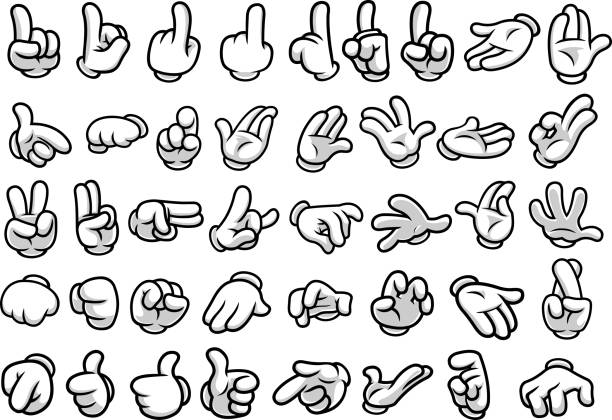Drawing cartoon hands, as well as feet, presents a unique challenge yet is crucial forbringing cartoon characters to life. These elements are vital for showcasing expressions, gestures, and the ability to manipulate objects, thus playing a significant role in storytelling through illustration.
The Role of Hands in Cartoon Expression
Cartoon hands are instrumental in mirroring a character’s emotions, complementing facial expressions to set the tone of the scene. For instance, a joyous character may be depicted with arms wide open and palms exposed, while an irate figure might be shown with fists clenched tightly, arms at their sides. The physical attributes of hands can also suggest gender differences, with male hands appearing more robust and female hands being depicted as more delicate and slender.
Techniques for Drawing Cartoon Hands
Method 1: The Oblong Palm Approach
This method begins with a basic oblong or cup-shaped figure to represent the palm. Subsequently, elongated oval shapes, resembling sausages, are added to outline the fingers, with an additional shape for the thumb. A small rectangle can serve as the wrist.
Method 2: The Oval Palm Technique
An alternative approach involves starting with an oval shape for the palm, followed by sketching in lines to delineate the fingers and thumb. This framework is then fleshed out to form the complete hand, suitable for characters with unusually long or distinct fingers.
Detailed Steps for Each Technique
Steps for the Oblong Palm Approach
- Begin with the Palm: Sketch a small oblong shape;
- Add the Fingers: Attach elongated shapes to the top edge for fingers, including one for the thumb;
- Outline the Hand: Draw around the combined shapes to define the hand;
- Add Detail: Insert a line next to the thumb for added depth.
Steps for the Oval Palm Technique
- Palm Foundation: Start with an oval shape for the palm;
- Sketch the Fingers: Draw small lines to form the fingers and thumb;
- Complete the Outline: Enclose these elements in a comprehensive outline;
- Adapt for Creativity: This method is particularly effective for drawing hands of fantastical beings.
Comparative Table: Techniques for Drawing Cartoon Hands
| Feature | Oblong Palm Approach | Oval Palm Technique |
|---|---|---|
| Starting Shape | Oblong or cup-shaped for the palm | Oval shape for the palm |
| Finger Formation | Elongated ovals (sausages) for fingers and thumb | Small lines for fingers and thumb |
| Complexity | Simple and straightforward, ideal for beginners | Slightly more complex, suitable for varied characters |
| Versatility | Best for human characters with standard hand shapes | Excellent for fantastical or exaggerated characters |
| Detailing | Minimal detailing, focusing on overall hand shape | Allows for additional detailing and unique features |
| Time Efficiency | Quick to draw, suitable for animations | Requires more time, but offers creative flexibility |
Adapting Techniques for Character Type
The choice between the oblong palm approach and the oval palm technique can be influenced by the character’s nature and the story’s context. For instance, the oblong palm approach, with its simplicity and efficiency, is particularly suited to animated characters that require rapid, repetitive drawing. Conversely, the oval palm technique, allowing for a greater range of motion and expression, is ideal for characters that demand more detailed and nuanced hand gestures.
Incorporating Hand Gestures into Storytelling
Hand gestures are a powerful tool in visual storytelling, capable of conveying a wide range of emotions and actions without the need for text. An open hand can signify peace or an offering, while a clenched fist might indicate anger or determination. By carefully choosing the hand posture and expression, illustrators can add depth to their characters’ personalities and enhance the narrative without overt exposition.
Practice Makes Perfect: Developing Your Style
Developing a unique style for drawing cartoon hands involves experimentation and consistent practice. Begin by mastering the basic techniques outlined above, then gradually introduce variations and details to distinguish your characters. Observing real-life hand gestures and how they convey emotion can also provide valuable insights. Over time, you will develop a repertoire of hand gestures and styles that breathe life into your illustrations, making your characters more relatable and your storytelling more impactful.
Conclusion
Mastering cartoon hand illustrations enriches character design and expression, offering endless creative possibilities. Whether depicting human characters or imaginative creatures, the key is to utilize simple shapes and lines for a solid foundation. Experimentation and practice are crucial in developing a style that brings your cartoon characters to life with expressive and dynamic hands.
